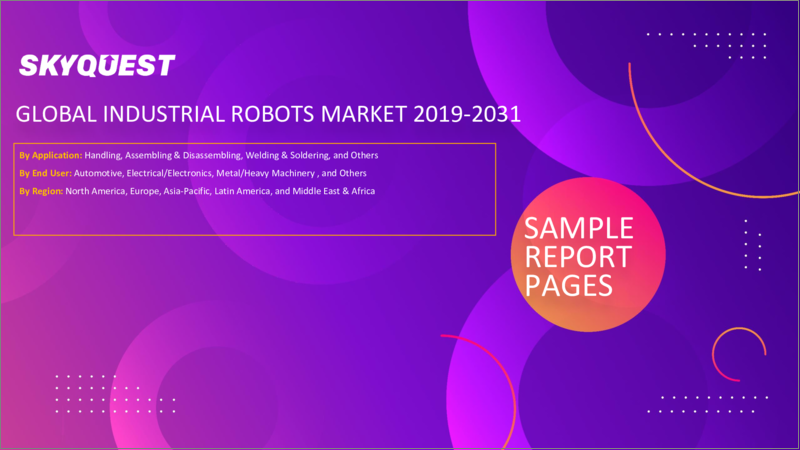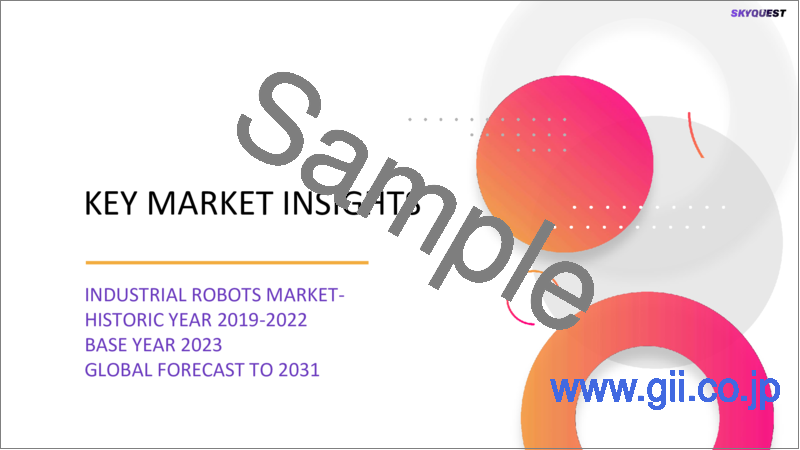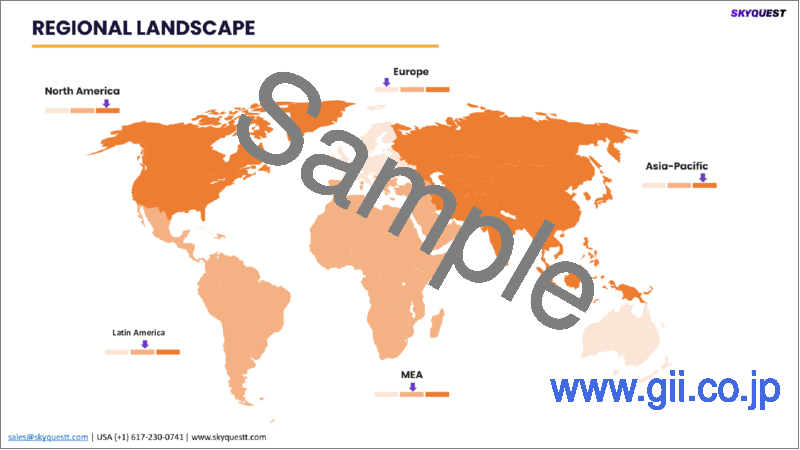|
|
市場調査レポート
商品コード
1427174
産業用ロボットの世界市場規模、シェア、成長分析、用途別、最終用途別- 産業予測2023-2030年Global Industrial Robots Market Size, Share, Growth Analysis, By Application(Handling, Assembling & Disassembling), By End Use(Automotive, Electrical) - Industry Forecast 2023-2030 |
||||||
| 産業用ロボットの世界市場規模、シェア、成長分析、用途別、最終用途別- 産業予測2023-2030年 |
|
出版日: 2024年02月12日
発行: SkyQuest
ページ情報: 英文 157 Pages
納期: 3~5営業日
|
- 全表示
- 概要
- 目次
産業用ロボットの世界市場規模は、2022年に265億2,000万米ドルと評価され、予測期間(2024-2031年)のCAGRは10.50%で、2023年の293億米ドルから2031年までに651億4,000万米ドルに成長する見通しです。
産業用ロボットの世界市場は、多様な産業の生産プロセスを自動化し強化するために、先進技術と産業専門知識を融合させ、現代の製造業に変革をもたらす役割を果たしています。洗練されたセンサー、アクチュエーター、インテリジェントなプログラミングを備えた産業用ロボットは、世界中の工場の効率性、精度、生産性を向上させています。溶接、組立、マテリアルハンドリングなど、精密さと再現性が要求される作業において、企業はオペレーションの最適化、ワークフローの合理化、人間の関与を最小限に抑えるために産業用ロボットを採用しています。オペレーショナル・エクセレンスの追求が市場の成長を後押しする一方で、多額の初期投資、統合やトレーニングの複雑さ、離職や労働力のスキルアップに関する懸念などが課題となっています。これらの課題に対処するために、ヘルスケアや物流におけるサービスロボットの探求と並んで、AIとMLの統合、カスタマイズされたソリューション、協働ロボットの能力拡大を通じて機会が生まれます。
産業用ロボットの世界市場の規模を推定・検証し、その他の様々な依存サブマーケットの規模を推定するために、トップダウンアプローチとボトムアップアプローチを使用しました。市場規模を推定するために使用した調査手法には、以下の詳細が含まれる:2次調査を通じて市場の主要企業を特定し、1次調査と2次調査を通じて各地域における市場シェアを決定しました。この全手順には、主要企業の年次報告書および財務報告書の調査、CEO、副社長、取締役、マーケティング担当役員などの業界リーダーからの重要な洞察を得るための広範なインタビューが含まれます。シェアの割合や内訳はすべて二次情報を用いて決定し、一次情報によって検証しました。本調査でカバーする市場に影響を与える可能性のあるすべてのパラメータを考慮し、詳細に調査し、一次調査を通じて検証し、最終的な定量的・定性的データを得るために分析しました。
産業用ロボットの世界市場セグメント分析
産業用ロボットの世界市場は、用途、最終用途、地域でセグメント化されます。用途別では、ハンドリング、組立・分解、溶接・はんだ付け、クリーンルーム、ディスペンシング、加工、その他に区分されます。用途別では、自動車、電気・電子、金属・重機、化学・ゴム・プラスチック、食品、その他に区分されます。地域別では、北米、欧州、アジア太平洋、中東・アフリカ、ラテンアメリカに区分されます。
世界の産業用ロボット市場の促進要因
熟練労働者の不足は、特に製造業などの分野で顕著であるため、企業は生産性を維持し、品質基準を維持するために、産業用ロボットなどの自動化ソリューションを導入するようになった。例えば、エレクトロニクスや自動車などの分野で事業を展開する企業は、労働力不足に対処し、生産目標を達成するためにロボット技術を採用しました。
世界の産業用ロボット市場における抑制要因
産業用ロボットの調達と統合に必要な多額の初期費用は、中小企業が自動化を取り入れる際の抑止力として働く可能性があります。しかし、技術の進歩やスケールメリットの効果により、産業用ロボットに関連する費用は着実に減少しています。
確立された製造ワークフローに産業用ロボットを組み込むには、複雑な問題があり、多大な時間を投資する必要があります。企業にとって、ロボットと他の機械やシステムとのシームレスな同期を保証することは極めて重要です。このような統合の複雑さは、特に自動化の導入経験が浅い企業にとっては、迅速な導入の妨げになる可能性があります。
世界の産業用ロボット市場の動向
2022年には、自動化を推進するために産業用ロボットに人工知能(AI)を組み込むことが重視されるようになった。AIを搭載したロボットは、データを分析することで瞬時に判断を下すことができ、それによって適応性と効率性を高めることができます。例えば、AIを搭載したロボットは、常に変化する環境下での進路や動きを強化することができます。
持続可能なオートメーションは、企業が環境フットプリントの最小化を目指す中で、顕著なトレンドとして浮上しました。エネルギー効率を優先し、廃棄物を最小限に抑えるように設計されたロボットが好まれるようになった。例えば、エネルギー消費量や排出量が少ないロボットは、環境意識の高いメーカーの間で人気を集めました。
目次
- エグゼクティブサマリー
- 調査手法
- 親市場の分析
- 主な市場の考察
- 技術分析
- 価格分析
- サプライチェーン分析
- バリューチェーン分析
- 市場のエコシステム
- IP分析
- 貿易分析
- スタートアップ分析
- 原材料の分析
- イノベーションマトリクス
- パイプライン製品の分析
- マクロ経済指標
- 主な投資の分析
- 主な成功要因
- 競合の程度
- 市場力学と見通し
- 市場力学
- 促進要因
- 機会
- 抑制要因
- 課題
- 規制情勢
- ポーターの分析
- 将来の混乱についての特別な考察
- 市場力学
- 産業用ロボットの世界市場:用途別
- 市場概要
- ハンドリング
- 組み立てと分解
- 溶接とはんだ付け
- クリーンルーム
- ディスペンサー
- 加工
- 産業用ロボットの世界市場:最終用途別
- 市場概要
- 自動車
- 電気
- 金属・重機
- 化学薬品
- ゴムとプラスチック
- 食品
- 産業用ロボットの世界市場規模:地域別
- 市場概要
- 北米
- 米国
- カナダ
- 欧州
- ドイツ
- スペイン
- フランス
- 英国
- その他欧州地域
- アジア太平洋
- 中国
- インド
- 日本
- 韓国
- その他アジア太平洋地域
- ラテンアメリカ
- ブラジル
- その他ラテンアメリカ地域
- 中東・アフリカ(MEA)
- GCC諸国
- 南アフリカ
- その他中東・アフリカ地域
- 競合情勢
- 上位5社の比較
- 主要企業の市場ポジショニング(2021年)
- 主な市場企業が採用した戦略
- 主要成功戦略
- 市場における最近の活動
- 主要企業の市場シェア(2021年)
- 主要企業プロファイル
- ABB(Switzerland)
- FANUC Corporation(Japan)
- Yaskawa Electric Corporation(Japan)
- KUKA AG(Germany)
- Kawasaki Heavy Industries Ltd.(Japan)
- Universal Robots A/S(Denmark)
- Mitsubishi Electric Corporation(Japan)
- Denso Corporation(Japan)
- Comau S.p.A(Italy)
- Nachi-Fujikoshi Corporation(Japan)
- Epson Robots(Japan)
- Staubli International AG(Switzerland)
- Omron Corporation(Japan)
- Adept Technology Inc.(United States)
- Hanwha Robotics(South Korea)
- FANUC Robotics America Inc.(United States)
- Panasonic Corporation(Japan)
- Toshiba Machine Co., Ltd.(Japan)
- Hyundai Robotics(South Korea)
- KAWASAKI Robotics GmbH(Germany)
- Aurotek Corporation(Taiwan)
- Siasun Robot & Automation Co., Ltd.(China)
Global Industrial Robotics Market size was valued at USD 26.52 Billion in 2022 and is poised to grow from USD 29.30 Billion in 2023 to USD 65.14 Billion by 2031, at a CAGR of 10.50% during the forecast period (2024-2031).
The Global Industrial Robotics Market serves as a transformative influence in modern manufacturing, blending advanced technology with industrial expertise to automate and enhance production processes across diverse industries. Equipped with sophisticated sensors, actuators, and intelligent programming, industrial robots drive efficiency, precision, and productivity in factories worldwide. Companies adopt industrial robotics to optimize operations, streamline workflows, and minimize human involvement in tasks requiring precision and repeatability, spanning applications such as welding, assembly, and material handling. While the pursuit of operational excellence propels market growth, challenges include the substantial initial investment, complexities in integration and training, and concerns about job displacement and workforce upskilling. Addressing these challenges, opportunities emerge through AI and ML integration, customized solutions, and the expansion of collaborative robot capabilities, alongside the exploration of service robotics in healthcare and logistics.
Top-down and bottom-up approaches were used to estimate and validate the size of the Global Industrial Robotics Market and to estimate the size of various other dependent submarkets. The research methodology used to estimate the market size includes the following details: The key players in the market were identified through secondary research, and their market shares in the respective regions were determined through primary and secondary research. This entire procedure includes the study of the annual and financial reports of the top market players and extensive interviews for key insights from industry leaders such as CEOs, VPs, directors, and marketing executives. All percentage shares split, and breakdowns were determined using secondary sources and verified through Primary sources. All possible parameters that affect the markets covered in this research study have been accounted for, viewed in extensive detail, verified through primary research, and analysed to get the final quantitative and qualitative data.
Global Industrial Robotics Market Segmental Analysis
Global Industrial Robotics Market is segmented on the Application, End-Use and region. By Application, the market is segmented into Handling, Assembling & Disassembling, Welding & Soldering, Cleanroom, Dispensing, Processing, Others. By End-Use, the market is segmented into Automotive, Electrical/Electronics, Metal/Heavy Machinery, Chemical, Rubber, & Plastics, Food, Others. By region, the market is segmented into North America, Europe, Asia Pacific, Middle East and Africa, and Latin America.
Drivers of the Global Industrial Robotics Market
Shortages of skilled labour, particularly prevalent in sectors like manufacturing, prompted firms to deploy automation solutions such as industrial robots to sustain productivity and uphold quality standards. For instance, businesses operating in fields like electronics and automotive embraced robotic technology to address labour shortages and achieve production goals.
Restraints in the Global Industrial Robotics Market
The substantial initial expenditure needed to procure and integrate industrial robots may act as a deterrent for smaller businesses in embracing automation. Nevertheless, with technological advancements and the effect of economies of scale, the expenses associated with industrial robots are steadily diminishing.
Incorporating industrial robots into established manufacturing workflows can present complexities and require significant time investment. It's crucial for companies to guarantee seamless synchronization of the robots with other machinery and systems. This integration complexity may impede rapid adoption, particularly for firms with limited experience in implementing automation.
Market Trends of the Global Industrial Robotics Market
In 2022, there was a heightened emphasis on integrating artificial intelligence (AI) into industrial robots to drive automation. AI-enabled robots are capable of making instantaneous decisions by analysing data, thereby enhancing their adaptability and efficiency. For example, robots equipped with AI can enhance their paths and movements in environments that are constantly changing.
Sustainable automation emerged as a prominent trend as companies aimed to minimize their environmental footprint. There was a growing preference for robots engineered to prioritize energy efficiency and minimize waste. For instance, robots that consume less energy and emit fewer emissions gained popularity among environmentally conscious manufacturers.
Table of Contents
- Executive Summary
- Market Overview
- Wheel of Fortune
- Research Methodology
- Information Procurement
- Secondary & Primary Data Sources
- Market Size Estimation
- Market Assumptions & Limitations
- Parent Market Analysis
- Market Overview
- Market Size
- Market Dynamics
- Drivers
- Opportunities
- Restraints
- Challenges
- Key Market Insights
- Technology Analysis
- Pricing Analysis
- Supply Chain Analysis
- Value Chain Analysis
- Ecosystem of the Market
- IP Analysis
- Trade Analysis
- Startup Analysis
- Raw Material Analysis
- Innovation Matrix
- Pipeline Product Analysis
- Macroeconomic Indicators
- Top Investment Analysis
- Key Success Factor
- Degree of Competition
- Market Dynamics & Outlook
- Market Dynamics
- Drivers
- Opportunities
- Restraints
- Challenges
- Regulatory Landscape
- Porters Analysis
- Competitive rivalry
- Threat of Substitute Products
- Bargaining Power of Buyers
- Threat of New Entrants
- Bargaining Power of Suppliers
- Skyquest Special Insights on Future Disruptions
- Political Impact
- Economic Impact
- Social Impact
- Technical Impact
- Environmental Impact
- Legal Impact
- Market Dynamics
- Global Industrial Robots Market by Application
- Market Overview
- Handling
- Assembling & Disassembling
- Welding & Soldering
- Cleanroom
- Dispensing
- Processing
- Global Industrial Robots Market by End Use
- Market Overview
- Automotive
- Electrical
- Metal/Heavy Machinery
- Chemical
- Rubber & Plastics
- Food
- Global Industrial Robots Market Size by Region
- Market Overview
- North America
- USA
- Canada
- Europe
- Germany
- Spain
- France
- UK
- Rest of Europe
- Asia Pacific
- China
- India
- Japan
- South Korea
- Rest of Asia-Pacific
- Latin America
- Brazil
- Rest of Latin America
- Middle East & Africa (MEA)
- GCC Countries
- South Africa
- Rest of MEA
- Competitive Landscape
- Top 5 Player Comparison
- Market Positioning of Key Players, 2021
- Strategies Adopted by Key Market Players
- Top Winning Strategies
- By Development
- By Company
- By Year
- Recent Activities in the Market
- Key Companies Market Share (%), 2021
- Key Company Profiles
- ABB (Switzerland)
- Company Overview
- Business Segment Overview
- Financial Updates
- Key Developments
- FANUC Corporation (Japan)
- Company Overview
- Business Segment Overview
- Financial Updates
- Key Developments
- Yaskawa Electric Corporation (Japan)
- Company Overview
- Business Segment Overview
- Financial Updates
- Key Developments
- KUKA AG (Germany)
- Company Overview
- Business Segment Overview
- Financial Updates
- Key Developments
- Kawasaki Heavy Industries Ltd. (Japan)
- Company Overview
- Business Segment Overview
- Financial Updates
- Key Developments
- Universal Robots A/S (Denmark)
- Company Overview
- Business Segment Overview
- Financial Updates
- Key Developments
- Mitsubishi Electric Corporation (Japan)
- Company Overview
- Business Segment Overview
- Financial Updates
- Key Developments
- Denso Corporation (Japan)
- Company Overview
- Business Segment Overview
- Financial Updates
- Key Developments
- Comau S.p.A (Italy)
- Company Overview
- Business Segment Overview
- Financial Updates
- Key Developments
- Nachi-Fujikoshi Corporation (Japan)
- Company Overview
- Business Segment Overview
- Financial Updates
- Key Developments
- Epson Robots (Japan)
- Company Overview
- Business Segment Overview
- Financial Updates
- Key Developments
- Staubli International AG (Switzerland)
- Company Overview
- Business Segment Overview
- Financial Updates
- Key Developments
- Omron Corporation (Japan)
- Company Overview
- Business Segment Overview
- Financial Updates
- Key Developments
- Adept Technology Inc. (United States)
- Company Overview
- Business Segment Overview
- Financial Updates
- Key Developments
- Hanwha Robotics (South Korea)
- Company Overview
- Business Segment Overview
- Financial Updates
- Key Developments
- FANUC Robotics America Inc. (United States)
- Company Overview
- Business Segment Overview
- Financial Updates
- Key Developments
- Panasonic Corporation (Japan)
- Company Overview
- Business Segment Overview
- Financial Updates
- Key Developments
- Toshiba Machine Co., Ltd. (Japan)
- Company Overview
- Business Segment Overview
- Financial Updates
- Key Developments
- Hyundai Robotics (South Korea)
- Company Overview
- Business Segment Overview
- Financial Updates
- Key Developments
- KAWASAKI Robotics GmbH (Germany)
- Company Overview
- Business Segment Overview
- Financial Updates
- Key Developments
- Aurotek Corporation (Taiwan)
- Company Overview
- Business Segment Overview
- Financial Updates
- Key Developments
- Siasun Robot & Automation Co., Ltd. (China)
- Company Overview
- Business Segment Overview
- Financial Updates
- Key Developments
- ABB (Switzerland)




